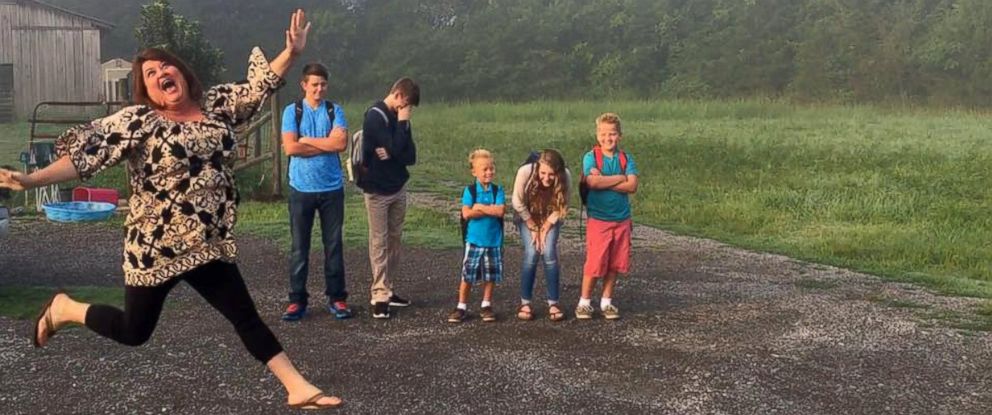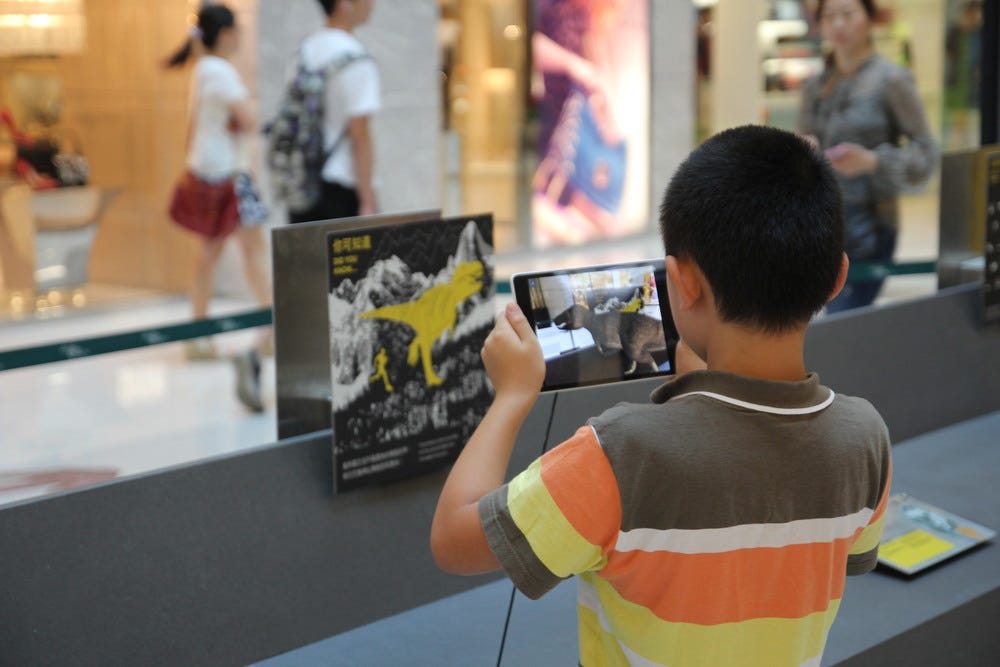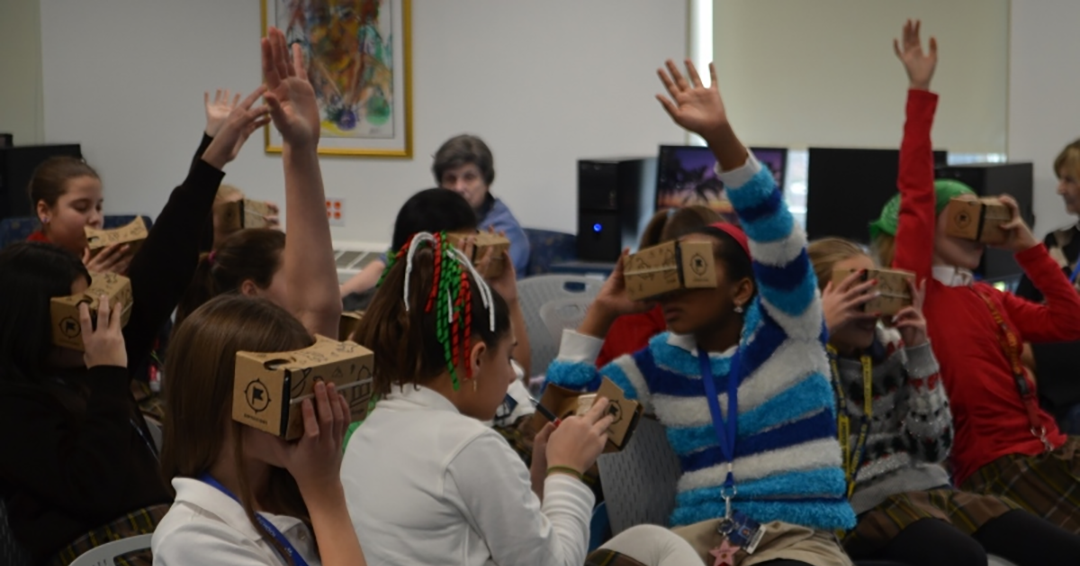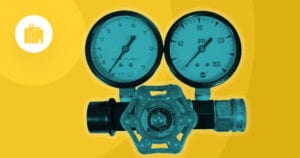
Despite the calendar’s insistence Autumn does not start until September 22, there’s a chill forming in the air, trees are changing from greens to golden hues, and children are filing back to school rooms across the U.S.

Hilariously honest first-day-of-school photos plaster the walls of social media accounts. Meanwhile, children attending K-12 level schooling stuff their backpacks based off the sixty-four-page documents indicating this year’s supply needs.
So, as another school year begins, what educational advancements are forming to give our young learners the best opportunities in the future?
As it turns out, quite a bit. Augmented and virtual realities are claiming stronger holds on many parts of our lives, and K-12 education will also benefit from this technology.

Why is it Beneficial?
[bctt tweet=”Augmented and virtual realities are claiming stronger holds on many parts of our lives, and K-12 education will also benefit from this technology.” username=”iotforall”]
When it comes to education, just about everyone can agree on at least one thing:
We should, whenever possible, utilize the most advanced options in order to teach children in the most effective and efficient ways.
Technology will continue to play a larger role in the education system as tools are curated for better opportunities and more customized lessons based off of school, class, and student needs. Right now, we are seeing AR and VR filling current gaps in the systems.
Now, I know what you may be thinking: “My co-worker, Donna, has a neighbor whose grandson is friends with a kid that has a VR headset, and she says he just plays games and watches videos. How is that educational?”
That is likely true. Afterall, lying about having a coworker named Donna who has a neighbor whose grandson is friends with a kid that has a VR headset seems rather unnecessary. And, it is also likely this kid spends the vast majority of his time with the headset just playing games. That is, however, a byproduct of what is currently made available to him.
As both augmented and virtual reality evolve, we will continue to see changes in how we use these everyday. Today, we are beginning to see how they will impact the schooling we once had to trudge through with only books, pencils, and notepads as our trusty tools.
Imagine, if you will, no longer needing to tell younger generations of your awful school trek through ten feet of snow, uphill both ways. Instead, you could simply show them a VR video allowing them to experience the daunting daily venture in a near lifelike scenario.
The above isn’t probably the best use for VR when it comes to education-related story-telling. First off, your enjoyment of telling your previous hardships is slightly odd. Secondly, there is virtually no educational benefit to the child. Thirdly, and most importantly, we all know you made that up. You’re not fooling anyone.
There are real benefits of the use of the realities in schools, though. Instead of forcing a kid to sit through a dull 8:00 AM session of students each taking turns reading a paragraph from a history book’s passage on the Tudor reign, perhaps the class engages in a virtual reality session.
The class, all now eager beings of near endless pent-up energy, can be physically, mentally, and visually stimulated while learning. They enter a castle, something they no longer need to imagine as it sits before them and they look around at the people from a time we only see in period dramas.
From there, perhaps they sit in on a meeting while the king decides how to handle the conflict with France. Maybe they witness a coronation, or perhaps they are shown the true lifestyle of peasants during the time period. In all likelihood, it would be wise to tell, but not show, the end results of Henry’s gruesome marriages.
Gruesome guillotines eliminated, we now have a one-hour history class which is much more engaging than the previous out-loud reading lecture. It also appeals to a wider variety of students. We are learning more about how different students learn in different ways. Some prefer reading. Others need hands-on activities.
Some require visuals, and more still need to be physically active in order to retain the lessons. Virtual and augmented reality in educational institutions provide solutions to better serve students in all of these ways.
To some, this may seem far-fetched. Personally, I’m a bit jealous, as I grew up at a time when TVs were hauled into classrooms on rickety wheeled contraptions. These were the best days, as we knew that during this one hour of our day, our noses wouldn’t be shoved into the crease of a book.
Field trips were even more fun, as they allowed us to get out and move. We could socialize, engage with the world, and still learned as our day-out progressed. Field trips are educational, after all, but they are also costly.
Between organization of the parent approvals, children’s’ food, logistics, additional fees, etc., field trips cannot be utilized as much as anyone might like, but they do impart a different type of learning on their subjects, which is a benefit that cannot be overlooked.
This is where virtual reality steps in and becomes the hero we didn’t know we needed. (Small Dark Knight reference for anyone paying attention in class today.)
The above Tudor VR reference is becoming the modern-day field trip. While real-life field trips will likely continue in the same fashion as before, the new technology being offered gives us bigger, better and more abundant opportunities to show children things much further away than three hours. Instead, they can travel to different continents, planets, and even different times.

But, Seriously, Who Can Afford This?
We must take a pause, here, as my recent mention of the cost of a field trip likely had at least one reader asking how providing a VR headset for every student is cost effective. Excellent question—you get a gold star and an A+ for the day!
Right now, it’s easy to think of VR headsets as very costly items. It’s true, as some packages (including computers, headset, handsets, etc.) can easily top one to two thousand dollars. For a class of thirty plus a teacher, this can equate to $62,000 (if I remember my third grade math correctly).
This does not have to be the case, though. Cheaper alternatives are available. Google Carboard is a good example; they offer packages specifically geared toward education by way of what they call Expedition Kits. For a fraction of the cost, currently starting at $9,499 for thirty students, classrooms get everything they need to begin utilizing virtual reality in a school setting.
If this still seems unsurmountable in school systems that often struggle with providing classes with even the smallest necessities such as crayons and glue, I am nearly in agreement. However, there was also a time when I’m sure a great deal of people thought it would be ridiculous to consider computers in classrooms.
I remember taking typing classes on old-school typewriters (no age jokes, please). Eventually, the schools brought in a computer lab—yes, just one. Each class took turns playing some educational games, and we moved on to other subjects until the next exciting trip to the lab. That evolved into multiple labs, which slowly evolved, in some schools, into each student having their own laptop each year.
The same will happen with regards to AR and VR implementation. Slow at first, many schools will likely see all of their students sharing the same limited devices. Eventually, as AR and VR become more mainstream in our lives outside of schooling, we’ll see pricing become more competitive (with more brands playing in the field), and more students may have their own devices at the ready.

It’s a Safer Alternative. Let’s Protect Our Little Pint-Sizes.
OK, we got that scary money-stuff out of the way, so let’s go back to the fun parts. And, we’re already sold on the awesome idea of “the new” field trips. There are an abundance of other opportunities here, though.
Feeling all sentimental as I think back to my K-12 days, I can’t help but remember my class experiences with fondness. There was the time, for example, that I was doing a chemistry experiment. I was decked out in all the stylish gear — goggles, booties over my shoes, and a lab coat three sizes too big. On this particular day, I recall my chemistry teacher calmly approaching me as I called out that I’d spilt acid on my hand.
In all fairness, it was not a strong acid, as that could hardly be allowed around untrained students. And, my well-prepared teacher had all of the right protocols in place to prevent me from doing any serious harm to myself, despite my forever-clumsy nature. However, today’s technology changes this scenario altogether.
Let’s not discard the live demos or real-life labs, as those have their own benefits. But, instead, let’s add the option of virtual reality chemistry labs where students can experiment with more reactive (and commonly more dangerous) chemicals in a virtual environment where there is no danger to the students. What, then, are we allowing our students to gleam from a class that may open their eyes to a future passion?
How much more are we allowing them to learn? The old phrase, “seeing is believing,” has a great deal of truth attached. I learned a lot in my chemistry class, almost none of which has been retained to this day. I attribute most of this loss to the fact that the moments that were significant and stuck in my mind were interactive — the labs.
The reactions I memorized for tests, the ones I couldn’t test for myself due to their dangerous nature, are ones I would not be able to recite today if there was a virtual gun to my head. If I’d had the opportunity to experiment more, even in a virtual setting, I have no doubt my memories would be stronger and I would have learned information on the long-term.
Don’t Worry, AR Plays a Role, Too!
Our awesome new schooling doesn’t have to be restricted to the world of virtual reality, though. Augmented reality will play an equal, if not larger, role in K-12 education.
If we look at common classes, we often see a mass hatred for math. My personal belief is that people tend to dislike subject they don’t understand. So, let’s throw some love at math by allowing students to have a better grasp on the concepts.
Often we see the very earliest math concepts taught with objects such as M&Ms or small coins. When we teach a child of addition, we show them what it is.
“I have two M&Ms, and I add three M&Ms. Now how many do I have?” The student then counts the M&Ms, and they exclaim the answer, thrilled to understand the concept. Then, if they are relatively smart children, they promptly eat the learning props.
For the majority of children, even basic math is such an abstract concept that the only way to truly learn it is to find a visualization that helps to illustrate what’s happening. Once the basic concept is then understood, children can begin to figure things out without the visualization aids. And, as is often seen, memorization tests are then implemented.
(Potentially relevant side note: I am not broaching the subject of Common Core math here. I wasn’t taught it, and I don’t have children learning it. Plus, we’re talking about AR at the moment.)
So, at an early age, we utilize visual stimulation to learn the abstract concepts of math. That all goes away as we move on through the grades, though. Suddenly, kids are thrust into math concepts where letters and symbols are valid in equations, word problems insist that some guy named Joe is buying 113 watermelons, and the M&Ms have stopped making appearances.
But what if we could give our students more tools by the way of augmented reality? Instead of asking kids to use their mind’s eye to visual complex geometry with only the possible benefit of 2-D textbook diagrams, we can instead provide them with 3-D examples.
We see, as humans, in 3D. We are constantly utilizing the information around us to move within a 3D world. With pictures and diagrams, we have found ways to draw things in such ways that they represent 3D, but our brain actually works harder to make this connection.
When a portion of our mind is so focused on trying to create the 3D object out of a 2D image, how can we be expected to use all of our brainpower to solve whatever geometric problem before us?
However, if we are able to provide children with a 3D object, augmented into their real space, popping off their desks like bits from the math heavens, we then allow them to focus solely on the problem at hand, as another portion of their brainpower is not being directed elsewhere.
Augmented reality would continue to bring benefits in any class where “size” is being discussed. I recall a great many times someone would describe the size of something in football fields.
My takeaway every single time? “Must be big.”
That’s it. I don’t have some magical portion of my brain equating that unit of measure to anything particularly finite. I don’t have a football field perpetually trailing behind me as a reference. The reference is almost moot, but is given as a way to try to describe something of immensity.
Instead, we could provide our young ones with actual comparisons. Instead of stating a tyrannosaurus rex is the size of “X” football fields (seriously, who does that? I’ve never seen a football field standing up), we could show them the dinosaur standing right next to them by way of AR.
Who’s Doing This?
Education is an easy way to implement augmented and virtual realities outside of the gaming and entertainment industries. So, it should come as no surprise that many businesses are already staking their claim on this new market.
As stated above, Google’s Expedition Kits are one of the options for bringing the devices into classrooms. Devices are pointless without content, though. Google is offering content to be downloaded online. These are, at the moment, more on the end of virtual field trips to different areas.
Other businesses, I’ll use ClassVR as an example, focus mainly on content. With a focus on VR in education, they are creating content which fits within common existing curriculums. Subject matter ranges from nature to history and science to art.
In the AR realm, things are going a bit slower. This is not just in education, but in general. There are fewer dedicated businesses to augmented reality in education, but as more AR capable devices become available, such as glasses and smartphones, the content will rapidly evolve.
We have an opportunity to provide our young learners and future generations with better and more accessible platforms by imlpementing augmented and virtual reality in education. We should not only be excited by this, but we should feel is is our obligation to make it happen in the most beneficial ways.
Check out Part 2 of the Augmented and Virtual Reality in Education series where we pack our bags and hike off to college. In the meantime, check out the current state of AR & VR technology, as well as AR & VR in Retail, and Travel & Tourism.







 Related Podcast Episode
Related Podcast Episode




 Related Applications
Related Applications


 Latest IoT News
Latest IoT News









